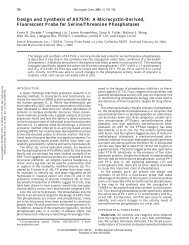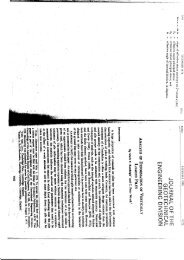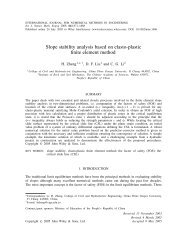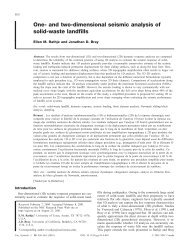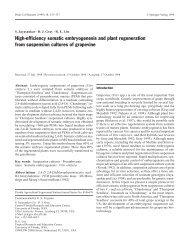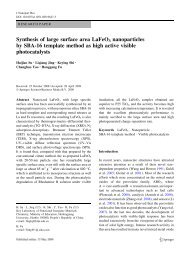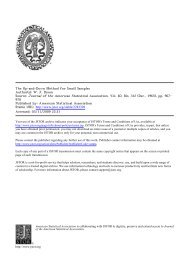PROPAGATION OF ELASTIC WAVES IN LAYERED MEDIA BY ...
PROPAGATION OF ELASTIC WAVES IN LAYERED MEDIA BY ...
PROPAGATION OF ELASTIC WAVES IN LAYERED MEDIA BY ...
Create successful ePaper yourself
Turn your PDF publications into a flip-book with our unique Google optimized e-Paper software.
382 BULLET<strong>IN</strong> <strong>OF</strong> THE SEISMOLOGICAL SOCIETY <strong>OF</strong> AMERICAby splitting the Laplace transform of the solution into rays and using Cagniard'stechnique for taking the inverse of the transform. Their method, which is entirelydifferent from the one used in this paper, offers an excellent independent meansfor checking our calculations.Figure 7 contains the theoretical seismograms we obtained for a eompressionalsource located midway between the surface and interface and having pulse widthsgiven by 4A = 1.2 and 4A = 1.6. Throughout the entire paper all time values in ourtheoretical seismograms, unless specified otherwise, are expressed in terms of thedimensionless variable t(v~l/d), where v~l is the shear velocity in the layer, d is thedepth of the source below the surface (or above the interface), and t is real time.For purposes of comparison with the graphs of Abramoviei we assume that theproperties for the surface layer and lower medium are Xl = m, p2 = (2/1.21)or,v02 = 1.lye1 and v82 = 1.1v,1. Hence vc2 > vc~ > vs~ > v~. The observation point istaken on the surface at a distance of five-layer thicknesses measured from the epicenter.Figure 8 contains the results given in Figure 11 of Abramovici. Note thatthe time values are expressed in terms of the dimensionless variable t(c/H), wherec = va and H is the thickness of the layer. Hence the time values in Figure 8 shouldfirst be multiplied by 2 before maldng any comparison between the two sets oftheoretical seismograms. The physical problem solved by the two different methodsare identical except for the analytical form of the input pulse. In the finite differencecalculation the potential function representing the input pulse was a quartie, as definedin equations (12) and (13), while in the work of the previously mentioned investigators,the input pulse was a quadratic.* We preferred the quartie pulse sincewe had the advantage of being able to use a much coarser grid. In making the comparison,we adjust the input displacements so that the pulse widths are the sameand the maxima occur at the same time. The shape of the curves differs slightly atpoints intermediate between the initial, maximum and end points. The agreementbetween the theoretical seismograms obtained by the two different methods isexcellent.(2) Effect of Different Mesh Sizes. Figure 9 shows a series of curves for threedifferent choices of mesh sizes for a typical layered half-space. A point source ofeompressional waves emitting a pulse of width 4A = 1.6 is located midway betweenthe surface and interface. The properties assumed for the surface layer and lowermedium are Xl = m, p2 = .801, vc~ = 1.5vcl and v~2 = 1.5va. Hence v~2 > v~l >v~2 > v~l. The observations point is on the surface at a distance of two-layer thicknessesmeasured from the epicenter. The first curve in Figure 9 is for a coarse mesh(At = .06, Ar = Az = .2), the second curve is for a medium mesh (At = .03,Ar = Az = .1), and the third curve is for a fine mesh (At = .015, Ar = Az = .05).Throughout the entire paper all distance values, unless specified otherwise, are expressedin terms of the dimensionless variable x/d, where x is real distance. Notethat the time scale on each curve is different because the number of steps used washeld fixed. Otherwise, the theoretical seismograms are the same, that is, they arefor the same input pulse, in the same layered half-space and measured at the sameobservation point. Note that there are some distortions in the amplitudes of some* The potential function for the quadratic is given by ¢0(t) = 1/A2[fo(t) -- 2f0(t -- A) +fo(t -- 2A)], where fo(t) = - (C/2R) (t - (R/v~))2H(t - (R/v,~)).



